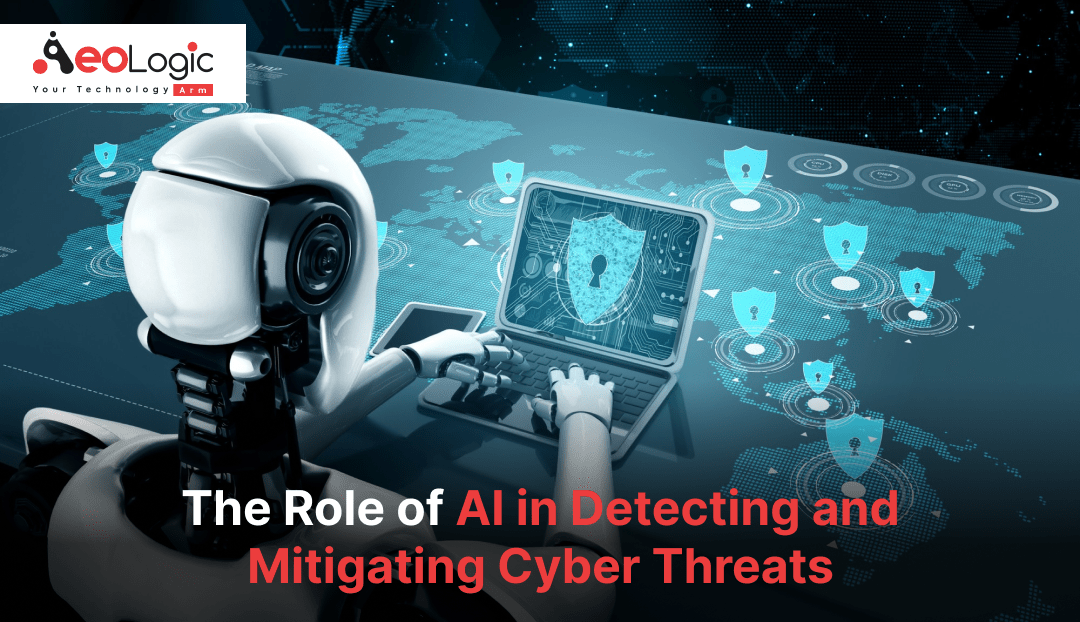Cyber threats are a serious issue today. Hackers are always finding new ways to attack. AI helps by detecting these threats quickly. It looks for unusual patterns and alerts us. AI also works to stop attacks before they cause harm. This technology is making online systems safer. AI learns and improves over time. It protects sensitive data and systems. Companies use AI to strengthen their defenses. AI can act faster than humans in critical moments. In this blog, we’ll explore how AI helps fight cyber threats.
Overview: AI in Detecting and Mitigating Cyber Threats
Cyberthreats are one of the most serious topics that are circulating the globe. The internet is the main culprit behind the introduction of cyberattacks but this depends on you how you use the internet and manage your security. But still after all precautions and awareness, many users face cyberthreats related issues daily. Cyber threats or attacks can be of various types, such as ramsworm, data breaching, blackmailing, etc. Statistics show that data breaches cost businesses an average of $4.88 million in 2024. Around 236.1 million ransomware attacks occurred globally in the first half of 2022. 1 in 2 American internet users had their accounts breached in 2021. The average number of cyber attacks per organization per week in the second quarter of 2024 was 1,636, a 30% increase from the previous year.
Importance of AI in Detecting and Mitigating Cyber Threats
To solve serious concerns like cyber threats, it is essential to evolve some technology or tools that could potentially mitigate and detect the ever-changing nature of this issue. Artificial intelligence, the powerful technology that has the potential to analyze data with machine learning and natural language processes, surely helps to mitigate and detect cyber threats. Through better cyber threat identification, mitigation, and prevention, artificial intelligence (AI) significantly improves cybersecurity.
Without depending on conventional signature-based techniques, it analyzes enormous volumes of data in real time using machine learning and sophisticated algorithms to spot anomalies and possible dangers like malware, phishing, and insider assaults. AI can forecast future attacks, automate solutions, and assist in enforcing security measures like Zero Trust models. It also enables proactive defense techniques like malware analysis and vulnerability management.
AI has been an incredible technology for every sector and established a reputation in the global market. Artificial Intelligence (AI) Market Size, Share, and Trends 2024 to 2034. The global artificial intelligence (AI) market size was USD 538.13 billion in 2023, calculated at USD 638.23 billion in 2024, and is expected to reach around USD 3,680.47 billion by 2034, expanding at a CAGR of 19.1% from 2024 to 2034.
Many regions or organizations have already implemented artificial intelligence and are getting many benefits from it in detecting and mitigating cyber threats. 67% of cybersecurity professionals use AI primarily to create rules reflecting known security patterns and indicators (Ponemon Institute). 50% of organizations use AI to compensate for a cybersecurity skills gap. Let’s see!
Also Read: Emerging Cybersecurity Solutions for Government and Public Sector
What is AI in Detecting and Mitigating Cyber Threats?
AI has a bright future for enhancing cybersecurity with the application of artificial intelligence (AI) technologies, such as machine learning (ML), deep learning, and natural language processing (NLP), by automating threat detection, response, and prevention in identifying and mitigating cyber risks as possible factors. To find patterns, abnormalities, or malicious behaviors that might point to cyberattacks like malware infections, phishing attempts, or unauthorized access, artificial intelligence (AI) systems examine vast amounts of data from networks, systems, and user activity. There are many more benefits of AI that we will see later in the upcoming paragraph.
Key Benefits of Using AI for Detecting and Mitigating Cyber Threats
There are a lot of benefits of AI while implementing it for detecting and mitigating cyber threats. Here are a few key benefits mentioned below.
Enhances threat detection
Before mitigations, this is very necessary to detect the threat at what level and which type of threat is actually. This gives you a proper idea about taking prevention or finding solutions to mitigate that. Compared to previous methods, artificial intelligence (AI) can identify risks almost instantaneously by analyzing large volumes of network data and user activity in real time.
Signatureless threat prevention
Cyber threats generally are evolving in nature and are not easily found in the existing system. Also, the evolving nature of the threat does not extract any sign that could be used to detect it in the future. So detection of signatureless threats is quite a difficult job. Where AI-powered systems are better at identifying emerging or changing threats, such as ransomware or sophisticated malware, because they don’t rely on pre-existing attack signatures.
Predictive analytics
There could be many cyber threats that have past records too but without proper analysis of data, it is not easy to identify them. With Artificial intelligence technology, by analyzing historical data and identifying patterns, it is possible to predict and prevent potential attacks before they occur. This helps organizations strengthen their defense for these ever-relied threats.
Cost-effective
Detecting and mitigating cyber threats involves various processes that are repetitive most of the time. With AI, automation can automate repetitive tasks and reduce human labor. This overall increases the efficiency and also proves cost-effective in terms of threat detection and mitigation for organizations.
Increased accuracy
Accuracy is very important while handling these types of tasks or systems. Where AI can minimize disruptions and resource waste on pointless warnings by reducing false positives and effectively differentiating between legitimate activity and genuine threats using sophisticated machine learning models. This overall increases the accuracy of cyber threat detection.
Also Read: Cybersecurity Solutions for Government Agencies in the Digital Age
Challenges with AI While Implementing Cyber Threats
We have seen a lot of benefits of AI for the detection and mitigation of cyber threats. But there are a few challenges too as here are a few mentioned below.
- Data quality and availability can be a challenge while operating AI for cyber threats as it needs good quality and vast amounts of data. Any limitation cannot give you accurate results.
- Complexity in integration can be another challenge as it is not easy to integrate with existing systems. It takes a little time which can result in downtime sometimes.
- The initial cost of implementation can be another issue as it takes a lot of capital and many small organizations haven’t sufficient capital to take service of this technology to enhance cyber security.
Also Read: The Importance of Cybersecurity for Digital Transformation
Final Words
Artificial intelligence (AI) is revolutionizing the detection and mitigation of cyber threats with major benefits like quicker threat identification, real-time reaction, and proactive prevention. It is a crucial component of contemporary cybersecurity defensive measures due to its capacity to handle massive amounts of data, spot anomalies, and learn from changing attack patterns.
AI solutions help firms keep ahead of increasingly complex cyberattacks, improves threat detection accuracy, and automates responses. There can be many challenges too while implementing this technology like the initial cost of implementation, complexity, integration issues, etc. But overall, AI will surely continue to be a key component in protecting digital environments as cyber threats change, so long as its application is properly controlled and improved upon.






